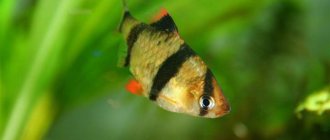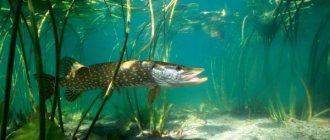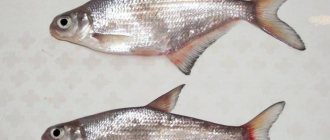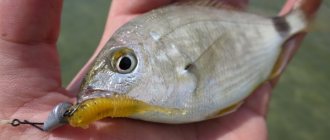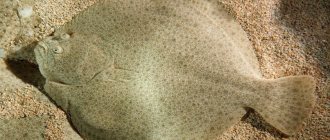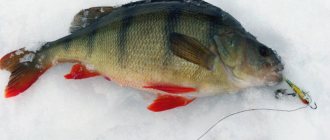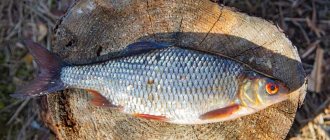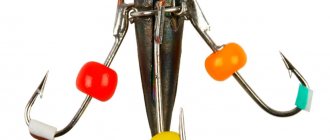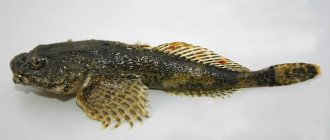This is an interesting representative of the large Flounder family, which numbers about 60 species of representatives. The fish has distinctive features such as a flat body and bulging eyes.
| Class | Ray-finned fish |
| Squad | Flounders |
| Family | Flounder/right-sided flounder |
| Genus | River flounders |
| View | Polar, star, black sea, yellowfin, common, white-bellied |
| Security status | Black Sea is listed in the Red Book |
| The average size | 35 cm |
| Lifespan | Males 20-25 years old, females 30 years old |
| What does it eat? | fish, worms, aquatic insects, arthropods, sometimes vegetation |
| Optimal feeding time | Morning or night (different for each subspecies) |
| Enemies | Eel, halibut, man |
| What do they bite on? | Small arthropods, molluscs, small fish |
What does flounder look like?
The most important distinguishing feature of the flounder is its eyes. They are convex and are located on the right side of the body. This is why the fish is called right-sided. Rarely, but still there are representatives in whom the organ of vision is on the left or evenly distributed on the sides.
Reference!
The left side, which has no eyes, is called the “blind side.” The skin here is dense, tough and rough. This feature protects the fish from attacks from enemies on the left side and improves movement over rocks and sand.
Description of the body structure of flounder:
- Torso. The flat body allows the sea creature to hide under a stone, bury itself in the sand, or simply lie unnoticed at the bottom. The lateral line runs exactly between the eyes. The skin on the “right side” is smooth and can change color to match the color of the bottom, which improves camouflage. The side that touches the bottom (left) is usually light in color.
- Head. The eyes are bulging and closely spaced one to one. The lateral line, which clearly separates them, allows the bulging eyes to perform their functions separately, which significantly expands the horizon. There are sharp teeth in the oral cavity, and the mouth is distorted. Nature gave this feature, and the fish takes advantage of it, capturing prey that swims from the side. The operculum is located on the left side.
- Fins. The caudal fin is shortened, but does its job well, helping the fish move quickly. The dorsal, on the contrary, is elongated, located close to the head. The pelvic fins are symmetrical. They have a narrow base and numerous rays. They help the predator to be dexterous and invulnerable.
Most often, the upper part of the body is brown, but the color depends on several factors: the species and habitat.
Description of individuals
Representatives of the flounder family live on average 20-30 years and have a rather unusual and interesting appearance, which makes it possible to distinguish it from other varieties of fish. The main distinguishing features are the following:
- the body is flat and plate-like, completely framed by a fin with many rays;
- asymmetrical head, turned to the right or left;
- eyes are closely spaced and function separately from each other;
- the slanted mouth has many sharp teeth;
- on the side of the body where the eyes are located, the scales are of a darker shade, and there is also a wide gill slit;
- the tail is very short and equipped with a fin without notches;
- the side that is devoid of eyes has a lighter shade and dense skin.
To survive in the sea and river, flounder has learned to adapt to any landscape and change body color
At birth, fish fry have the same structure and appearance as all other fish. But gradually irreversible metamorphoses occur, which lead to a shift of the mouth and eyes to the right side of the head.
After transformation, the fish turns over to the blind side , which gradually atrophies and begins to be used by the flounder as a flat belly for the convenience of lying on rocks and the bottom. But in river flounder, the changes occur in the opposite order - the eyes and mouth move to the left side of the head.
To survive in the sea and river, the fish has learned to adapt to any landscape and change body color. Because of this, it is often called the “water chameleon.”
Distribution area and lifestyle
Flounder is both a sea and river inhabitant. Where it lives, there must be satisfactory conditions for its existence. The fish is common in the northern latitudes of the Pacific Ocean. Significant numbers have been observed in the Chukchi, Mediterranean, Japanese, Okhotsk and Bering seas. Representatives of freshwater bodies of water live in the lower reaches and bays of rivers (Dnieper, Southern Bug, Dniester).
The salinity of the water in the Sea of Azov and the rivers flowing into it, which lower the water level, allowed the Black Sea flounder, a representative of the flounder, to settle at the mouth of the Don River. Those species that tolerate low temperatures well live in the waters of the White, as well as the Kara and Okhotsk seas. They can also be found in rivers such as the Yenisei, Ob, and Tugur Bay.
Flounder loves soft muddy bottoms. Spends a solitary life at the bottom, buried in the sand. He can spend days under a layer of sand and watch with his bulging eyes everything that happens around him. It can rise above the bottom at a level of a meter, but this rarely happens.
Mimicry is an important feature for flounder. This term means "camouflage". A fish, using this feature of its body, can deftly attack a prey and hide from other inhabitants of the seabed.
Flounder swims quite slowly, no more than 9-11 meters per hour. If you watch how it moves smoothly, it may seem that it is simply being carried along by the current. But this is only when the fish feels completely safe. When danger approaches, the speed of movement increases sharply. This is facilitated by the pectoral fins, tail and dorsal shortened fin located evenly opposite each other.
In the most dangerous and unusual situations, the flounder makes a sharp jerk forward immediately 4-5 meters. It leaves behind a powerful stream directed to the bottom. The water jet will raise mud from the bottom and disorient the attacking enemy. A similar phenomenon occurs due to the gill cover, which in the structure of the fish is located on the left side of the body.
Marine variety
Salt water is home to many species of flathead fish. They feel great both in shallow water and in deep water. All of them are characterized by very different sizes, shades of the sighted and blind sides, as well as different body shapes.
The most popular is the common sea flounder, which lives in slightly and highly saline waters at a depth of more than 200 meters. This individual is the most desired prey of fishermen. The main color of flounder is dark green with small orange or red splashes . It can reach one meter in length and 7 kg in weight. It perfectly knows how to blend into the bottom and hide from predators.
Bottom or white-bellied
It is also called sea bottom fish. A distinctive feature is the forked lateral line and sharp fin. The blind side is painted milky, and the sighted side is most often represented by a brownish-brown color.
In nature, there are two varieties:
- Southern white-bellied flounder, which lives in Primorye and the Sea of Japan.
- Northern - found in the Okhotsk, North and Bering seas.
Common and arrowtooth halibut
This species of flounder lives from the Atlantic to the Arctic Ocean. The largest size was observed in the white halibut living in the Pacific Ocean. It grows up to 450 cm in length and reaches a weight of 350 kg.
A distinctive feature of the halibut is the same color on the sighted and blind sides.
A distinctive feature of this species of flounder is the same color on the sighted and blind sides. The smallest representative of the species is the arrow-toothed halibut, which weighs only 7 kg and does not grow more than 80 cm.
Most fishermen consider halibut a real delicacy. But black fish is especially valued, which differs not only in the color of its scales, but also in the shade of its flesh.
Kinds
There are a huge number of species of flounder. Among them there are both sea and river inhabitants. They differ from each other not only in appearance, but also in the way they feed.
Let's look at some species of the Flounder family:
- Star-shaped. This marine representative is characterized by a left-sided position of the eyes, which is quite rare for Kambalov representatives. The body color is brown, olive or brown-green. This representative received its name due to the beautiful pattern on the back and ventral fins. They resemble stars. Its average body length is 55 cm, and its weight is 4-4.5 kg.
- Yellowfin. Feels comfortable in cold water. Leads an active lifestyle. He also hunts in cold blood. Waits for small fish and a wide variety of representatives of the sea day. A distinctive feature of this variety is the rounded shape of the body and spines along the entire perimeter of the right side of the skin. The color is yellow, closer to golden. The length of the sea predator is about 50 cm, but, interestingly, it weighs only 1-1.3 kg.
- Ordinary. A representative of the Kambalovs, widely found in the seas, has a brown tint with red circles scattered on it. This representative has a very well developed ability to camouflage. An individual in adult life grows up to 1 meter in length and weighs about 6.7-7 kg.
- Chernomorskaya. Another name is kalkan. This species is considered rare and is therefore listed in the Red Book. The Black Sea flounder has a rare left-sided eye position. The body is round and dark brown with speckles. The main feature of the Kalkan is its thorns. They are located throughout the body, but most of them are on the right side (blind spot). The predator grows up to 1 meter in length, weighing more than 20 kg.
- Royal. The fish deservedly received this name. She has a rich black color and bright red spots all over her body. The tail, like most species, is not spread. The scales are small and beautiful. The skeleton has no small bones. Her meat is tender, tasty and healthy, for which she is valued in cooking. Distributed in waters from Norway to Siberia. Length 35 cm, weight about 4 kg.
- Kamchatskaya. It is also called “sugar”. The slaves received this second name for the taste of the cape. Lives off the coast of the Kamchatka Peninsula. The color is yellow, even closer to lemon color. The skin on the “blind half” is gray. Length about 40-45 cm, weight up to 5 kg.
- Polar. This marine representative thrives in cold environments. If the temperature rises above zero, these are already uncomfortable conditions for him. The body is elongated, oval. Skin color is olive, closer to dull green. The fins are red.
Far Eastern flounder is a collective image, not just one species. It includes several dozen fish that are similar in appearance. These include star flounder, yellowfin, white belly, and halibut. Distribution area: Far East. Weight varies depending on the representative, ranging from 250 g to 4.5 kg.
Gerbil and Stonewall
Towards the end of spring, during high tide, the gerbil flounder comes to the sandy bays of the Okhotsk, Barents Seas and the Primorsky Territory to spawn; it is distinguished by a smooth body on both sides, a small mouth, a round shape and has dietary meat. Females lay up to 3.5 million eggs. At this time, it can be caught at a distance of up to 50 m from the shore, at a depth of 10 meters.
The eyes are located on the right side, some of their varieties, such as the starfish, have chosen a freshwater way of life, but the gerbil is a sea fish, up to 50 cm in size, weighing up to 3 kg.
Stonefish - swims and spawns in the same waters as the gerbil flounder, but unlike it, it is covered with spiny growths, reaches a length of 55-58 cm, weighs up to 3 kilograms.
It is omnivorous, easy to catch, so it is of interest to fishing enthusiasts, it tastes great, but is very difficult to process due to large polyps on the skin.
Sinekoraya
Marine, demersal species, depth range 13-60 m, lives in the Pacific Ocean: Bay of Bengal, northwestern Australia, South China Sea, China, Taiwan, Japan, Vietnam and Indonesia. The main color is brown-gray with dark spots, the fins are lighter than the body, and there are two black stripes on the tail. The blind side is whitish in females, while in males it has a distinct bluish-black pear-shaped pattern. Bluebark is ovoid in shape, has a small head, and has two rows of teeth on the upper jaw and one on the lower jaw.
On an industrial scale, fishing is carried out using the trawl method; due to its presence in the water column, fish meat does not contain toxins and has antioxidant properties. In cooking, it is highly valued for its pleasant taste and aroma; delicious snacks are prepared from it for all kinds of drinks.
Spotted
The body outline is more or less oval, looking very compressed and asymmetrical. The upper profile of the head is slightly concave, forming a pointed muzzle, large eyes, and a mouth with teeth in one row. The lateral line is noticeable on both sides, the color is light gray or brownish with spots. Size - 15-39 cm, features - dark brown spots scattered on the underside over a white or white-red background.
Flounder fish lives in: coastal waters of the northeastern, eastern, central, southeastern parts of the Atlantic Ocean, the Mediterranean and Black Sea. Adults live on soft bottoms, from the shoreline to a depth of about 300 m, and feed on small fish and crustaceans.
Halibut
The giant flounder of the genus Hippoglossus, which sometimes leaves the ocean floor and swims vertically, is a marine game fish of the North Atlantic and Pacific Oceans, one of the largest bony fish. The easiest way to tell halibut apart is by their size. Halibut looks much larger than any average flounder by 10 or even 20 times.
Their description: pointed dorsal and anal fins give them a characteristic diamond shape. They have slightly concave tails that end at certain points; most others are flat or rounded, with the eyes always located on the right side. The bone scales are covered with a comb of denticles (ctenoid), the upper cover is gray-brown with inconspicuous spots, the abdomen is bluish.
Pacific halibut lives from the west coast of Alaska to the northwestern part of the United States, Atlantic halibut appears from Cape Cod to Greenland and further to northern Europe. Alaska is a hub for halibut fishing.
Halibut tastes firmer and meatier, while flounder fish is more delicate. The absence of fat and dense meat, which can be grilled or fried over an open fire, pleases gourmets from all over the world.
Now the Atlantic reserves of this monster are critically depleted, leaving Pacific waters where fishing is more sustainable. Numerous videos on the Internet show how these giants are caught.
Big diamond
Pilvina, turbot - this is also the name of this species, of the Kalkan family, has a length of 80-100 cm, industrial dimensions - 45 cm, weight - up to 25 kg, color varies from grayish to brown. There are no scales, only small bony tubercles, a huge mouth with a protruding lower jaw and sharp teeth. The eggs are hatched from 1-9 million, the eggs are small, the fry, having reached 3 cm, sink to the bottom and adapt to lead an adult lifestyle.
It is found along the entire coast of Europe, the Baltic, the Gulf of Finland, and the Gulf of Riga. One subspecies lives in the Black Sea, and another even smaller subspecies of Kalkan lives in the Azov Sea. It feeds on small fish and crabs; meat is highly valued - it is an expensive commercial item.
Sole
Ten years ago, Greenpeace added this fish to its seafood red list. The Greenpeace International Seafood Red List is a list of fish commonly sold in supermarkets around the world that have a very high risk of extinction from unsustainable fisheries.
Dover halibut, soleya, sole, whatever the name is for this little fish that looks like an animal's tongue. It prefers low deep temperatures, where it leads a sedentary lifestyle, only coming to coastal waters to spawn from early to late spring. Its color is light brown with darkish spots, the eye side is on the right. The tip of the upper pectoral fin is painted black, making it easy to identify this representative of the flounder. The body is covered with continuous small scales, which are removed with a whole strip when cleaning.
Often on the shelves of domestic and foreign stores, Pangasius (catfish family) is passed off as the sole due to the slight external resemblance of the fish.
What is included in the diet
Each subspecies feeds at different times - some during the day, others at night. Basically, flounder prefers animal food, but if it was not possible to catch anything, it can also snack on vegetation or other representatives of fauna. These can be aquatic insects, small arthropods, worms, algae.
Reference!
The favorite food of flounder is capelin and shrimp. Thanks to its sharp teeth and twisted mouth, the fish can easily gnaw through the shell of aquatic inhabitants and eat them out.
Black Sea Kalkan
Flounder, which lives in the Black Sea, is called kalkan and is a very valuable and tasty fish. Moreover, it has commercial significance. For example, in Turkey, a kilogram of Kalkan costs at least fifteen dollars. In the middle of the last century, two to three tons of this fish were caught annually off the coast of Crimea. However, soon its reserves decreased significantly, which became the reason for the ban on its catching. Currently, there is no such ban, which leads to a decrease in its number. The fish are caught using multi-kilometer nets that block the migration routes of the Kalkan for spawning. This is the traditional way of catching it. This phenomenon is considered illegal, and recently such catching has become quite large-scale, which can lead to a critical decrease in the number of Kalkan in the Black Sea.
Kalkan lives not only in the Black and Azov Seas, but also enters the Mediterranean, as well as at the mouth of the Dnieper and Dniester. This species of flounder prefers sandy and silty soils, and does not fall below one hundred meters. Kalkan, which lives in the Sea of Azov, is called Azov. In principle, it is no different, only slightly smaller in size than the Black Sea.
Since this is a predatory fish, its diet includes mollusks, crustaceans, and small fish. Juveniles generally prefer crustaceans, while adults tend to eat fish and crabs.
Flounder breeding
In order for the reproduction process to occur, each species requires its own specific conditions. This is heating the water, the habitat, maintaining the correct temperature, which is optimal for eggs (eggs). If we take average indicators, then flounder begins to reproduce from mid-December to May. There are representatives who are comfortable giving birth to offspring in the summer. This is the Big Diamond and Turbot. Marine species of the Flounder family go to the seas to spawn.
For the reproduction process to begin, fish must reach sexual maturity. Age directly depends on the species. Basically, males are ready for procreation from 3-7 years of age, females a little earlier. Everything is individual, and largely depends on the environment.
Flounder has good fertility. During the spawning period, a female individual leaves up to 12 million eggs, 1 mm in size. Since the eggs are able to swim independently in a horizontal direction, they easily spread throughout the world. Such a high prevalence threatens their lives, since eggs can end up in freshwater bodies.
The incubation period depends on the water temperature. In the southern regions, embryonic development occurs on 1 day. Where the water is cold, the process lasts more than two months. When the eggs are in the water column, they are transparent. As soon as they sink to the bottom, metamorphoses begin to occur.
The fry are actively searching for food. Most often they feed on small inhabitants of the bottom. Once the diet becomes saturated, further development continues. In right-sided flounders, the left eye moves smoothly to the right side. At the same time, the left side becomes the tummy.
Reference!
For unknown reasons, the sides may be formed in reverse. That is, the right eye shifts to the left side. It has been noticed that a similar developmental deviation occurs among river inhabitants.
Life expectancy depends on the sex of the individual and its distribution area. Females live about 30 years, males 5-10 years less.
How physics explains the structure of fish
Why is flounder flat? Physics interprets this as follows. This fish lives at great depths where the pressure is very high. And in order not to experience overload, it has this shape. The body from above is subject to minimal pressure.
Why is flounder flat? This is also explained by the benthic lifestyle, which contributes to the redistribution of pressure load.
Most members of the family live in coastal waters, at moderate depths, and only a few travel more than 1 thousand meters to search for food. Certain species live in salt water. They can go up the river.
Enemies
Flounder is of enormous industrial importance, so its most dangerous enemy is man. Huge quantities of this fish are caught every day all over the world. In addition to the fact that a person poses a great danger to her life, aquatic inhabitants are also not averse to feasting on her cape. The enemy in the natural environment is eel and halibut.
And if everything is clear with the eel, because it is a predator that hunts various fish, then the halibut looks very much like a flounder, and some even consider it a subspecies of the Flounder family. But in fact, halibut is not related to flounder in any way, so they can compete with each other.
Nutrition
Flounder has various “dishes” on its “table”; its diet is varied: plankton, small mollusks, worms, as well as crustaceans and crustaceans. She can also eat shrimp and small fish - for example capelin, if they swim very close to the place where she is hiding, although she does not like to leave her shelter often, lest she herself become someone's lunch. It prefers to burrow in sandy soil, where it can also find food for itself; its jaws are well adapted for this.
Fishing for flounder from a boat
In order for fishing to bring a catch, an inexperienced fisherman needs to use some tips.
So, what you need to do to catch flounder:
- You can use a spinning rod that is not long; even a winter one will do in this case.
- The thickness of the fishing line for a spinning rod should be 0.6 mm, for a leash 0.35 mm.
- As bait you can use small fish, both whole and pieces, worms, small shellfish.
- Fishing in shallow water involves throwing the bait to the side. The second cast must be done in the other direction. At depth, the bait is launched vertically.
- After the bite, you can be sure that the flounder remained on the hook, because its mouth is not only strong, but also twisted.
- You need to take a gaff with you into the boat, because if you manage to hook a flounder, it will be much more difficult to pull it out.
Many fishermen dream of catching flounder. For fishing to be successful, you need to choose a catchable place and take all the necessary gear with you.
Flounder is a healthy fish. Its meat has an amazing taste and contains substances beneficial to the body. 100 g contains only 90 kcal. In addition to the fact that it is caught on an industrial scale, it is also hunted by ordinary amateurs. And this threatens the population decline.
Harm and benefit to humans
Fishing for flounder
Nutritionists consider flat fish a medicinal product.
The composition of valuable substances makes flounder useful for diseases such as:
- hypothyroidism;
- cardiovascular diseases;
- chronic gastritis;
- cholecystitis;
- autoimmune diseases;
- chronic fatigue syndrome;
- anemia.
The benefits of flounder
In addition to dietary nutrition for chronic diseases, flounder is good in a regular diet.
Its beneficial properties provide:
- gaining useful weight during pregnancy;
- rapid recovery after serious illnesses;
- cancer prevention in older people;
- increasing mental performance and memory in schoolchildren and students;
- increased sexual desire;
- improving the structure of hair and nails;
- cleansing the skin, increasing its turgor.
Damage to flounder
Fish, as a rule, is not harmful to health. The health value of fish depends on the method of preparation. Flounder loses most of its beneficial properties when salted, smoked, or canned.
Flounder prepared in these ways can harm various organs of the human body:
- salted flounder retains fluid in the body, leading to edema and unhealthy weight gain;
- salted flounder puts excessive stress on the kidneys;
- salted and dried flounder concentrates salt in the joints, which leads to arthritis;
- smoked and canned fish are the source of carcinogens.
Important! Dried flounder without salt retains almost all valuable substances. But dried fish should not be eaten by people with gastrointestinal diseases.
